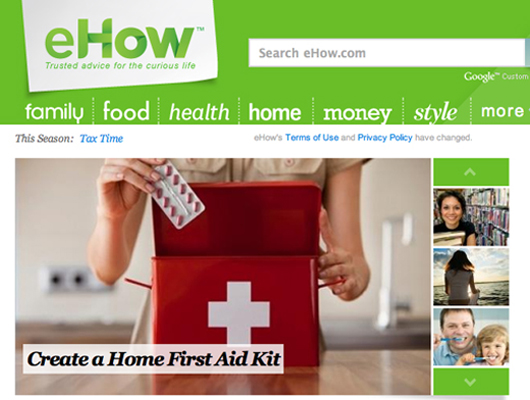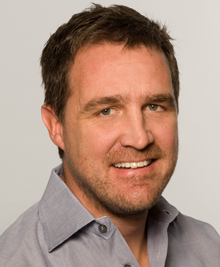Business content on MediaShift is sponsored by the weekend MA in Public Communication at American University. Designed for working professionals, the program is suited to career changers and public relations or social marketing professionals seeking career advancement. Learn more here.
Content farms. Content mills. Robo-content.
Demand Media and its huge how-to site eHow have been called snarky names for years, largely because they pay low rates for quickly produced content based on popular search queries. So it’s no surprise that a search for “how to grill fish” on Google produces this eHow article up near the top of the results.
Last year, MediaShift ran a week-long special report, Beyond Content Farms and one report by Corbin Hiar included a Demand Media writer saying that her haphazard report on “How to Make Gin at Home” could poison someone. Now, eHow execs tell me that they’re taking steps to improve quality.

“I know there was so much conversation out on the web about low quality content,” said Greg Boudewijn, eHow’s senior vice president and general manager, in a recent interview. “We realize we’re human and there’s going to be pieces of content that slip through that aren’t great. Whatever we can do to provide means to continue to improve the processes and the content that exists on our site, that’s something we take to heart. We applaud Google for their changes, and applaud any site that focuses on quality.”
A recent redesign of eHow created colorful channel pages for Family, Food, Health, Home, Money, and Style. The cleaner look is being augmented with longer form feature stories, a video webisode series about the popularity of food trucks, and a content deal with Rachael Ray in the Food section. More importantly, eHow added new “Helpful?” buttons at the end of each article so people could provide direct feedback on whether articles are useful — which will lead to more oversight of writers.
Despite a recent change in Google’s algorithm to filter out poor quality content, eHow actually benefited from the change, according to both comScore and Sistrix. I spoke to both Boudewijn and Jeremy Reed, the senior vice president of content and editorial at Demand Media, in a wide-ranging interview. While they admitted they weren’t on a path to match the New York Times, they were frank about their push into service journalism — especially with the number one most trafficked home and garden site. Below is an edited transcript, with audio clips, from that phone interview.
Q&A
What were the main improvements with the redesign of eHow?
Greg Boudewijn: We were looking at this site as the next evolution of our site and user experience. It was a little more than four years since we touched it, it was 2007. Demand Media acquired eHow in 2006, so you can imagine that four years on the web is like 30 in real life. In that time, eHow had grown phenomenally based on our unique content model. It was time to re-architect the back end to handle the scale of innovation and development faster, and we wanted to launch more sites internationally.
We introduced a new eHow logo and color palette to introduce a more consumer brand. We wanted to create more of an emotional connection for them, and the best way we did that was the introduction of six core channels at the top of the header. Each channel has its own color palette and own look and feel. If you look back 10 years to the AOLs and Yahoos of the world, doing portal hubs — a little bit of an antiquated term — they had huge amounts of traffic coming through their front doors. And they could funnel that traffic to core verticals like news, finance and entertainment.

Our model is very different. We made each individual content page as an entry point to our site. Over time, we saw audiences growing in certain core verticals and those are the ones we chose to use for our channels. People were coming repeatedly to certain topics so when we created the channel pages, we used them to create new content types. Everything from long-form video webisodes to blogs and posts from experts. We partnered with Rachael Ray for our food category. The experts can be personalities or brands.
In the home channel, we have Home Depot to help users fulfill what they’re looking for. It’s about simplification. You have the steps to do something and can go out and buy it. The new site is a springboard to expand the media company to cater to more than how-to articles.
You were thinking of every story as an entry point but now you have vertical sections. Why? Because of traffic patterns you saw?
Boudewijn: We still view articles and videos as entry points whether people get there from search or social networks. What we saw was that we were amassing audiences of a scale that was much larger than sites on the web that only focused on that specific topic. That was evident with the home category, where for more than the past year, we’ve been the number one home and garden site on the web. We felt it was our responsibility to make a front door for that and program it daily with a rich experience.
Tell me more about the new longer form stories and features.

Jeremy Reed: One of the things we’ve always focused on is the idea of utility. But there’s also the opportunity to entertain them or take them to the next step or direct them to another place. We have 15,000 active people in our community [of contributors] throughout the U.S. — we have filmmakers, copy editors, writers. They were very good at creating this specific kind of content, but they also have experience writing feature content, or filmmakers had experience doing longer form content. We had a talent base in our community, so it made sense on the business side and an opportunity for that community so they could grow their career.
Was the business reason for doing longer stories so that you could improve the time spent on your site?
Reed: When we look at content, we look at many signals. We look at content that could hold its weight next to branded advertisers, and content that people would want to share. In the last month, we had 100,000 articles shared through Facebook. So it’s trying to figure out compelling content based on the signals coming to our site.
Boudewijn: It’s about completing the user experience. We’ve done a really good job doing articles of a certain length and type. So what happens now is, because we’ve created these channels, the content we create in one channel can be fundamentally different than in others. We’re providing something with an expert voice, and something they can follow daily. It has more of a personality and engagement factor.
How has pay for writers evolved at eHow, and will you change compensation with this redesign?
Reed: We’ve always had a range in compensation. We’ve paid anything from $7.50 for a short-form tip to more than $100 for feature articles. Different ranges for filmmakers. I think the price that we pay has certainly gone up. We pay our writers twice a week, so if they turn in an article on a Sunday, we pay them on Tuesday. If they turn an article in on Wednesday, we pay them on Friday, regardless of the amount paid.
Reed explains how eHow is transparent to writers about how much they’ll get paid and let writers of similar content see how much everyone in that subject gets paid:
Does pay vary according to topic or length of story?
Reed: We look at different factors like subject area expertise and how much time it takes to write it and other factors like that.
How is this redesign targeted at advertisers? You mentioned there would be more “touch points” for them in your press release about the redesign.
Boudewijn: We were very good at providing a utility, and there was content programmed on the home page focused on how-to, but not differentiated by category. When we acquired eHow in 2006, branded sales wasn’t a big part of our business. We relied primarily on third party relationships with advertising affiliates. Over time, with the hiring of Joanne Bradford [from Yahoo to be chief revenue officer of Demand Media], branded advertising has become a bigger part of our business. Those advertisers want to own the consumer experience. They want to see their placement on the page and see the integration. They want to know the boundaries around where that exists.
So when we did the redesign, we looked at aesthetics of the site but also looked at places where advertisers could come in and buy sponsorships or packages. One thing that’s unique about what we do is our content is all intent-driven. We’re not an entertainment site or news site where people come to the front door and say, “entertain me.” But eHow is intent-driven; people come with a specific mission and we want to help fulfill that. That’s a very meaningful experience and a funnel that advertisers want to be a part of.
Plus, we wanted to position experts. Brands want to be associated with the Rachael Rays of the world and expert knowledge that’s honest and genuine. That’s a great opportunity for advertisers to wrap around eHow Food. And there’s also an opportunity for brands as experts. So for the Home Depots of the world … a user coming to the site recognizes an advertiser that adds value to the experience, and it helps them.
Boudewijn explains how Home Depot will help users as an “advertiser presence” that will help users complete tasks.
You’ve added this “Helpful?” button to get feedback from readers. How does that work?
Boudewijn: We’ve been very good at listening to signals out on the web, whether through search or social to understand what content we should create. eHow has a massive audience, and it’s one thing to be in the studio evaluating writers on a number of metrics — their grammar, their quality, their experience. That’s an academic way. But we want to know how our content resonates with people who are using it in on an everyday basis. So these buttons are the first step of a curation layer to understand how helpful our content is in the real world.
Right now we let people tell us if it’s helpful, and they can “like” it or share it on Facebook and Twitter. If they don’t think it’s helpful, then we’re gathering reasons on why it might not be helpful for them, and funnel that information back to our editorial team to help enrich our content and inform our guidelines on what to produce. That’s just our first step, there will be other hooks on the page to solicit feedback in the coming months.
Reed: One of the things we’ve done from the beginning is make sure we understand the quality of the content by the people who use it. We’ve let people make comments and ratings on stories, but we wanted to go back to ask the specific question: Was this helpful or not? Like Greg was saying, we can take that information and go back to the writer and decide if we want to give them more work, or are they better in one subject than another. It’s a constant, targeted feedback loop from someone who’s engaging with that content.
I noticed on Compete.com that the traffic for eHow went down about 7 percent in visits and 4percent in unique visitors for February 2011. Was that related to what happened with Google changing its search algorithm?
Boudewijn: February is naturally a shorter month. Most businesses on the web, going from a 31-day month to a 28-day month, especially with the two holidays for Valentine’s Day and President’s Day, you have a lot of events that make businesses fluctuate. We’re now Top 10 in the U.S., according to comScore. I don’t rely heavily on third-party analytics that we don’t have direct influence over, so I can’t necessarily comment on Compete’s numbers.
Google makes algorithm changes all the time, but when they make it public, people seem to gravitate to them. We’ve seen them make a number of changes, and we see ups and downs. Our business continues to grow and we haven’t seen any material effect from [Google’s algorithm changes].
(Editor’s Note: In a follow-up query to comScore, the research firm also found a slight drop in traffic to eHow in February, but attributed it to the shorter month as well, and noted that the Google-referred percentage of traffic to eHow is actually slightly higher in February than January.)
Are there other things you’re doing to improve the quality of content?
Boudewijn: If you look at the way we produced content two years ago, it’s fundamentally different than the way we do today. One of the unique things we’re doing is creating these channels and aligning writers in Demand Studios with those channels. We’re also vetting the talent to make sure they’re qualified to write for us. Content quality is such a broad term. You could take the New York Times’ content and put it on someone’s blog and put 15 AdSense ads around it and show it to 100 people and they’d say it’s terrible.
Content quality comes down to the process by which it’s created, and we stand behind our editorial process. At eHow, we want to make sure it’s a quality experience for users and for brands and advertisers.
Reed: We did make a make a conscious effort to stay within what we could do responsibly within our model, within our community, within our scale. We didn’t go after investigative reporting like the New York Times does because we didn’t feel in the current equation that we could do it successfully. We went after this very service journalism, the utility kind of content. We started to see the value of subject matter expertise, and an editorial process. We wanted people to come through the door with years of experience, so that it makes sense for them as part of their career.
Our editorial rigor includes plagiarism checks, citing references, going through a copy editor so we felt good about that content. We have a very large taxonomy, so we’ve tried to cut that up so everyone has subject matter expertise, including the people who write the titles, who edit the copy, who select the photo, all the way down to the people editing it and giving it the final OK.
Boudewijn says they realize there will be some pieces of content that slip through ‘that aren’t great,’ but they’re trying to improve:
How do you vet the people that you hire?
Reed: It’s on two levels. We qualify people who come in. If you’re a writer, you submit a resume and multiple clips and we have an in-house editor who vets that. If you’re a copy editor, it’s the same process but if you’re accepted there’s a copy editing test. So if you’re going to edit a section on automobiles, you get a test based on that subject. That’s one part of our approach. And then on each piece of content, every writer gets edited by a copy editor and has a possible re-write before it’s sent through. The copy editor then rates the writer on a 1 to 5 scale on grammar and on subject matter expertise.
We look at every single person and qualify them, and look at every single piece of content.
Do you own all rights to the content or can writers or videographers re-use the material?
Reed: We made the decision that if we would pay up front and pay for that piece of content that we would own it.
Boudewijn: That was one of our learnings over time, that ensures our editorial process and integrity. Early on, in 2006, we did allow people to come directly to eHow.com and submit content. We dropped that program last April because it didn’t make sense to put all the time and energy into producing content with a rigorous editorial process, and then have people submit things without any process. So today we stand behind our content because it’s completely owned by us.
*****
What do you think about eHow’s redesign and push for higher quality content? Do you use the site regularly or avoid it? Share your thoughts in the comments below.
Mark Glaser is executive editor of MediaShift and Idea Lab. He also writes the bi-weekly OPA Intelligence Report email newsletter for the Online Publishers Association. He lives in San Francisco with his son Julian. You can follow him on Twitter @mediatwit.
Business content on MediaShift is sponsored by the weekend MA in Public Communication at American University. Designed for working professionals, the program is suited to career changers and public relations or social marketing professionals seeking career advancement. Learn more here.
> A Twitter Chat About Writer Pay Rates in the Digital Age by Mark Glaser
> Special Series: Beyond Content Farms at MediaShift
> Don’t Blame the Content Farms by Dorian Benkoil
> Writers Explain What It’s Like Toiling on the Content Farm by Corbin Hiar
> Your Guide to Next Generation Content Farms by Davis Shaver

